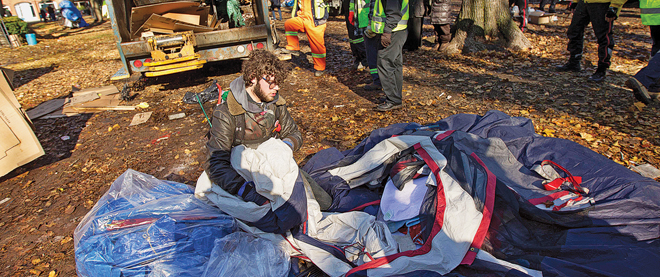Epilogue to Occupy
The Bay street lawyer who helped end Occupy Toronto explains tactics like giving the police daffodils
Chris Drost/ZUMAPRESS/Keystone Press
Share

Tim Gilbert is a 48-year-old lawyer on King Street in Toronto. His office is on the 20th floor of the TD Trust building, where it overlooks the financial district. He is the chair of Toronto’s Design Exchange (in what used to be the Toronto Stock Exchange) and the principal lawyer at his own patent and trademark firm, Gilbert’s LLP. He is hoping to put a large flat-screen television on the far wall of his office for Skype interviews and conference calls. He is a strong believer in free markets. He is also a friend of Occupy Toronto—and one of the people responsible for the peaceful outcome of the police eviction at St. James Park on the morning of Nov. 23.
Since then, tent cities have turned back into parks and editorial boards have turned to new topics, but Gilbert hasn’t been so eager to move on. Since the eviction, the intellectual property lawyer has been meeting with some of the movement’s organizers (a term he says he “uses loosely”) to discuss “the group’s next step.” “I don’t agree with many of their solutions,” he says. “But I think it would benefit them to have some degree of leadership and organization.”
The aftermath of Occupy—with park cleanups donated by businesses and rhetoric that’s seeped into the national dialogue—suggests the movement has made a dint in the national psyche.
Gilbert’s introduction to the Occupy movement was inadvertent. “I was in a board meeting one day,” he says, “when I saw people marching by the window with signs.” His continued interest afterwards was not. “I thought why not bring the people outside in, and have a conversation.” One conversation turned into many (Gilbert recalls squeezing into the narrow entrance of a yurt for his first meeting with Occupants), and an event was scheduled at the Design Exchange soon after—on one condition: that they promise not to occupy the building for more than a few hours. “There was some apprehension,” says Gilbert, alluding to fears that the occupiers would set up camp in the Design Exchange, “but I wanted to have a mix of people at the table.”
He got it. Seated among the protesters were former Toronto mayor David Miller, and a one-time chair of the World Economic Forum, David Kennedy. Everything went well. Still, the public perception of the process, the one we all read about and watched on screens, remained the same: Occupiers forever pitted against the Tim Gilberts of the world—the 99 per cent versus the elusive one per cent.
It’s this kind of cynicism that bothers Gilbert most. “I don’t think it’s an us-or-them situation,” he says. “I think [Occupy] is just a fascinating conversation.” Whether or not he agrees with the various talking points of that conversation is unclear and, to him, irrelevant. His goal isn’t to solve the economic crisis—“I wish I had the solutions,” he says—but to prove that those who do want to solve it on both sides of the issue can have civil and meaningful discussions together. Or as one Occupy facilitator, 21-year-old Mischa Saunders, put it, “Tim is committed to the fact that our politics should be secondary to the fact that we can engage one another.”
He’s also committed to using hindsight to create keener foresight and was haunted by the G20 confrontations. “I had been approached by a local counsellor to see if I could play a mediator’s role between the [Occupy] movement and the mayor’s office,” he says.
On the morning of Nov. 23, Gilbert received a text message from an Occupant, saying, “The police are here, can you come down?” He could, but not before dropping his 11-year-old daughter off at badminton practice. The first thing he did on arriving at the park was to hit the nearby Metro grocery store and buy out their stock of daffodils. “It’s hard for a police officer to club you over the head,” he says, “when you’re handing him a flower.” So protesters dutifully handed out flowers, and aside from a small group of determined diehards, people cleared out peacefully. “I told them to think of this as a win,” says Gilbert, stressing that he is, after all, a lawyer, and doesn’t support “illegal occupations.”
With people who are extraordinarily reasonable (even graciously so), it’s tempting to look for hidden agendas or feet of clay. The uncanny thing about Gilbert is how his own lack of cynicism manages to defuse it in the people around him as well. His leeriness of all things uncivil and ultra-partisan is obvious in the way he describes both the more extreme factions of the Occupy movement (think anarchists) and the movement’s detractors (think trickle-down theorists). “With people like that you know what the case is,” he says, and then paraphrases W.B. Yeats: “Hearts chained to a stone / To trouble the living stream.”